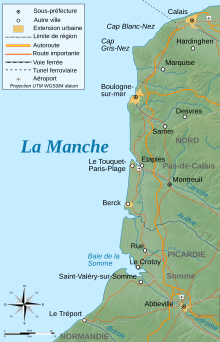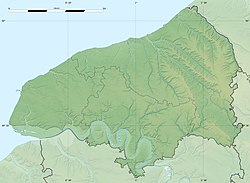|
User talk:Keith-264/sandbox3SB SBT SB2 S2T SB3 S3T SB4 S4T SB5 S5T AB
Clearing the Channel Coast was a task undertaken by the First Canadian Army in August 1944, in the Second World War after the Allied victory in the Battle of Normandy during the pursuit from Normandy into Northern France and Belgium. The First Canadian Army advanced from Seine to the Scheldt river in Belgium, blockading and capturing the Channel ports of Dieppe, Le Havre, Boulogne, Calais, Dunkirk, Ostend and the Scheldt Estuary. The First Canadian Army also overran launch sites for the V-1 flying bomb. The German 15th Army was able only to oppose the advance with sporadic resistance, wary of being outflanked and cut off by the rapid advance of the British Second Army on the inland flank of the Canadians. The 15th Army managed an orderly retreat north-eastwards towards the Scheldt, leaving troops behind in the fortified ports. On 4 September Adolf Hitler had declared the Channel ports to be fortresses but Dieppe and Ostend were taken unopposed. Le Havre, Boulogne and Calais were subjected to set-piece assaults, after massed bombing; an attack on Dunkirk was cancelled and the garrison besieged. Troops investing Dunkirk were freed for the Battle of the Scheldt, where the First Canadian Army reduced the Breskens Pocket, cleared the mouth of the Scheldt and opened Antwerp to Allied shipping. The composition of the First Canadian Army varied but for most of the period was composed of the II Canadian Corps and the I British Corps. At times, the 1st Czechoslovak Armoured Brigade, 1st Polish Armoured Division, French Maquis, the Dutch Prinses Irene Brigade and 1st Belgian Infantry Brigade (Brigade Piron) were under command. After Normandy, the Polish and Czech formations were reinforced by former conscripts of the German Army who changed sides. BackgroundFirst Canadian ArmyThe Battle of Normandy had been costly for the First Canadian Army, particularly in infantry. The I British Corps (Lieutenant-General John Crocker) had been attached to the First Canadian Army, with the 7th Armoured Division, 49th (West Riding) Infantry Division, 51st (Highland) Division and the British 6th Airborne Division (Major-General Richard Gale). The performance of the infantry and armour in Normandy had been criticised by Montgomery and the divisions had been relegated to the defence the eastern flank of the Normandy bridgehead. The 6th Airborne Division having landed on D-Day in Operation Tonga had not been withdrawn despite its lack of heavy weapons and had suffered many casualties. Gale had instructions to harry the German retreat and conserve its manpower at the same time. The 6th Airborne Division was reinforced by the 1st Belgian Infantry Brigade and the Royal Netherlands Brigade (Prinses Irene), which were to gain "operational experience in quieter sections of the line in the hope that ultimately they would return to their own countries and form nuclei around which larger national forces might be organized".[1] The I British Corps advanced along the Channel coast, with the II Canadian Corps on the right. 15th ArmyMuch of Army Group B (Heeresgruppe B) had been destroyed or shattered in Normandy and the Falaise Pocket but the divisions east of the Allied bridgehead were intact. When the German front collapsed in August there had few replacements or defences between Normandy and the Siegfried Line along the German border. Many troops left behind by the 15th Army to garrison "fortress cities" as it retreated along the Channel coast were second-rate and included some Austrian and other nationalities, not trusted enough to carry arms.[citation needed][2] PreludeNormandy to the SeineThe I British Corps had advanced eastwards from the River Dives along the channel coast. The 6th Airborne Division and attached units captured Troarn and overran the German coastal artillery at Houlgate but German flooding around Cabourg and positions nearby at Dozulé, slowed the advance across the Dives delta.[3] On 16 August, as soon as German resistance faltered. Reconnaissance had been ordered on 19 August and the authorization for a full advance and pursuit by the Canadians was issued on 23 August. General Bernard Montgomery, the 21st Army Group commander issued a directive on 26 August, that all German forces in the Pas de Calais and Flanders were to be destroyed and Antwerp was to be captured. The First Canadian Army was to to cross the Seine and capture swiftly Dieppe and Le Havre with minimal force and capture the coast as far as Bruges in Belgium. The main effort of the Canadians was to be on the right flank to make enveloping manoeuvres towards the coast and the First Allied Airborne Army would be on call. The Second Army was to operate inland of the Canadians and dash for Amiens, cutting the communications of the 15th Army as it retreated before the First Canadian Army.[4] The 1st Polish Armoured Division captured Ypres on 6 September and Canadian units were at Dunkirk on 7 September, fifteen days after the end of the Falaise Pocket (12 – 21 August 1944) despite their casualties. The Allies could not mask the Channel ports because they needed their facilities to import supplies for their armies. German long-range guns could shell Dover, threatening shipping in the Dover Strait and inland were launch sites for V-1 flying bombs bombarding London. Operation PaddleRelief map of the Calvados coast Montgomery hoped to inflict a defeat of the magnitude of the Falaise Pocket by trapping them against the Seine and the sea. The Third US Army had advanced northwards to Elbeuf, across the Second Army line of advance and cut off the route towards Paris but Army Group B held up the Canadians, protecting improvised river crossings and a substantial quantity of men and equipment were ferried over the lower Seine.[5] The towns along the River Touques were evacuated by the Germans around 24 August and the capture of Lisieux, about 45 km (28 mi) east of Caen, opened an important route eastwards.[6] Next day, the River Risle was crossed just north of Brionne by the 11th Hussars, with other units close behind. The 6th Airlanding Brigade of the 6th Airborne Division took Honfleur on the Seine estuary but progress along the coast was slower than inland, rivers being tidal, wider and more difficult to cross. The 6th Airborne Division occupied the west bank of the Risle from Pont Audemer downstream to the Seine on 26 August and returned to Britain on 3 September. Clearance of the last German units west of the Seine was completed on 30 August.[7] Seine crossingI British Corps put patrols across the Seine on 31 August. The advance to the Seine had outstripped the preparations of the Royal Canadian Engineers for bridging equipment and assault boats but newly assembled assault boats carried the 3rd Canadian Infantry Division across the Seine at Elbeuf on 27 August. Ferries for wheeled and armoured vehicles were in operation in the afternoon.[8] PortsDieppeDieppe had been abandoned by the Germans before the order Hitler sent for it to be defended as a "fortress" had been received and it was captured by the 2nd Canadian Infantry Division on 1 September, which had last been in the port during the Dieppe Raid in 1942. A ceremonial parade was held on 5 September and despite demolitions, the port was cleared and in use on 7 September, a delivery of oil and petrol being shipped to Brussels on 9 September.[9] Le HavreLe Havre was attacked by the I British Corps, supported by Hobart's Funnies, specialized armoured vehicles of the 79th Armoured Division and bombardment from land, sea and air. It was taken on 12 September after 48 hours but the port needed lengthy clearance and repair. Boulogne Map of the Côte d'Opale Boulogne was reached on 5 September but the garrison had received the Hitler "fortress" order. The city was protected by high ground and was attacked by the 3rd Canadian Division with extensive air and artillery support from 17–22 September. Rocket sitesOn 1 September, the last V-1 was launched against London as the Canadians were moving through the launch areas.[10] Calais and Cap Gris NezCalais was sealed off in early September and Wissant was quickly captured, though an early attack on Cap Gris Nez failed. The assault on Calais itself opened on 25 September and the town fell on 30 September. A second attack on the Cap Gris Nez batteries opened on 29 September and the positions secured by the afternoon of the same day. Despite the strong defences and although the city had been declared a Fortress, the garrison needed little persuasion to surrender and their reluctance to fight to the end was repeated at Cap Gris Nez. Dunkirk Modern map of Dunkirk (commune FR insee code 59183) Dunkirk had been reached by 7 September by the 2rd Canadian Infantry Division, which wass replaced on 16 September by the [[4th Special Service Brigade]] (4th SSB). On the night of [[nowrap|26/27 September,}} the 4th SSB was replaced by the 154th Infantry Brigade of the 51st (Highland) Division and the HQ of the First Canadian Army took over responsibility for the siege from the II Canadian Corps. During a truce on 3–6 October, 17,500 civilians left the city and on 9 October the 1st Czechoslovak Independent Armoured Brigade Group (Major-General A. Liska) took over from the Highlanders. The investing force also contained units of the French Forces of the Interior and a regular French infantry battalion. Neither side was passive during the siege and on 28 October, Czechoslovak independence day, a raid by the Czechs took 300 prisoners. On 27 November, the First Canadian Army relinquished command to the 21st Army Group and on 9 May 1945, General Liska took the surrender of the garrison.[11] BelgiumOstend had been omitted from Hitler’s list of "fortresses" and so was evacuated, despite its strong defences. The port had been demolished. The 1st Polish Armoured Division crossed the Belgian border and captured Ypres on 6 September, reaching the Ghent-Bruges Canal on 9 September.[12] ScheldtA long and costly operation was required to clear the Germans from both banks of the Scheldt. AftermathAnalysisAlthough Dieppe came rapidly into use, it could supply only a quarter of the needs of the 21st Army Group. The capture of Le Havre, Boulogne, Calais and Ostend only eased Allied supply problems after extensive clearance of debris and mines. Ostend was restricted to personnel only but the Boulogne terminal for a Pluto oil pipeline (Dumbo) was of great benefit, becoming the "... main supplies of fuel during the winter and spring campaigns" of the Allies.[13] It has been questioned whether the capture of the defended ports was worthwhile, given the need for much effort to bring them into use and the greater potential benefit of Antwerp.[13] The opening of Antwerp in November 1944 largely solved Allied supply problems.[citation needed] The capture of the French side of the Dover Straits removed the threat of the heavy artillery which had bombarded Dover for some years and endangered shipping in the Straits and the Royal Navy had emphasised the need to remove them. V-1 launch sites were overrun, reducing the threat to London.[citation needed] Canadian progress had not met the expectations of Montgomeryand its performance has been disputed since. It has been suggested that Crerar's illness in the autumn of 1944 provided a convenient opportunity to replace him during the Battle of the Scheldt.[citation needed] CasualtiesThe First Canadian Army operations against the Channel Ports of Le Havre, Boulogne and Calais to 1 October took the surrender of about 30,000 German troops.[14] From 4 September to 4 November the First Canadian Army had 17,000 casualties of whom 3,000 were killed or died of wounds; 68,000 troops of the 15th Army were taken prisoner.[15] notesFootnotes
References
Further readingBooks
Journals
Reports
|
||||||||||||||||||||||||||||||


